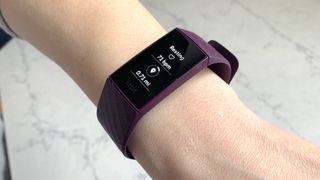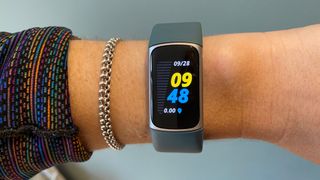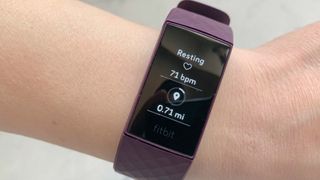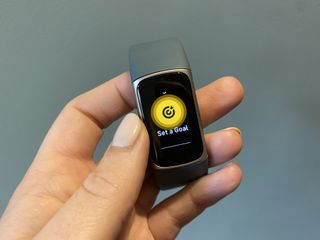Wondering what’s new between Fitbit Charge 5 and Fitbit Charge 4? Considered two of the best fitness trackers currently available, these activity bands are a popular choice for beginners and sports enthusiasts alike.
The Fitbit Charge 5 and Fitbit Charge 4 were released about a year and a half apart and serve a similar purpose in the brand’s range of devices. The Charge is the best Fitbit that isn’t a smartwatch, and with each generation the company makes a number of improvements.
The Fitbit Charge 4 introduced built-in GPS and activity zone minutes, while the Fitbit Charge 5 initiated a redesign, an EKG reader, and more. These functions are also included in Fitbit’s premium smartwatches, such as the Fitbit Sense, but are more advanced for a fitness tracker.
So if you’re wondering if you need to upgrade to the Charge 5 or which is the better price for a first-time purchase, this Fitbit Charge 5 vs. Fitbit Charge 4 Face-Off can help. Here are the biggest differences to consider.
Fitbit Charge 5 vs. Fitbit Charge 4: Specifications
| Fitbit Charge 5 | Fitbit Charge 4 | |
|---|---|---|
| price | $ 179 | $ 149 |
| size | 1.45 x 0.9 x 0.44 in | 1.43 x 0.69 x 0.4 in |
| weight | 1.02 ounces | 0.92 ounces |
| advertisement | Color AMOLED touch screen | Grayscale OLED touch screen |
| Sensors | Heart rate, EKG, SpO2, EDA, GPS | Heart rate, SpO2, GPS |
| Battery life | 7 days | 7 days |
Fitbit Charge 5 vs. Fitbit Charge 4: Price
The Fitbit Charge 4 started at $ 149, which was on the high end for fitness trackers. For example, the best cheap fitness trackers are all under $ 100. But with additional features, Fitbit has raised the Charge 5’s price to $ 179.
While the Fitbit Charge 4 regularly goes on sale with the best Fitbit deals, the Charge 5 doesn’t get frequent discounts. It’s still pretty new, that may change over time.
Today’s best Fitbit Charge 5 and Fitbit Charge 4 deals
Fitbit Charge 5 vs. Fitbit Charge 4: Design
The Charge 4 looks almost exactly like its predecessor, the Fitbit Charge 3. It has a sharp rectangular design with a grayscale OLED touchscreen and silicone straps that wrap around your wrist. A single touch-sensitive area on the left side of the Charge 4 acts as a back button. It also comes in black and a maroon plastic case.
(Photo credit: Toms Guide)
You will notice several aesthetic changes to the Charge 5. For one, it has a stainless steel case that is available in black, silver and gold. The metallic accents are raised, making this fitness tracker something you actually want to wear outside of the gym. The curvier face also adds a fashionable touch.
(Photo credit: Future / Tom’s Guide)
In addition to a redesigned case, the Charge 5 has a colored AMOLED touchscreen that is twice brighter than the screen of the Fitbit Charge 4 and offers an always-on option. It is easy to see even in direct sunlight. Color animations and notifications make Charge 5 look more like a semi-smartwatch than a regular fitness tracker, although there are plenty of inexpensive activity bands that also offer a color display.
Fitbit Charge 5 vs. Fitbit Charge 4: Features
Both the Fitbit Charge 5 and Charge 4 are rugged fitness trackers. You can use them to count your steps, track your heart rate throughout the day, and monitor your sleep overnight. When you exercise, they monitor your elapsed time and distance traveled, if applicable, via GPS. While none of the screens are large enough to show all of the advanced metrics that serious runners want, check out the best running watches or the best GPS watches for alternative options.
(Photo credit: Toms Guide)
The Fitbit Charge 5 is more advanced than the Charge 4 with an electrodermal activity sensor (EDA) to detect stress and an EKG sensor that can detect signs of atrial fibrillation. However, the ECG function is currently not available. Fitbit’s daily readiness rating feature will also be announced along with the Fitbit Charge 5. When it’s live, it pulls in three different metrics – your fitness fatigue (activity), your heart rate variability (HRV), and your last sleep – to tell you how ready your body is to exercise. This tool could be one of the most important factors in deciding whether the Apple Watch vs. Fitbit is right for you.
(Photo credit: Future / Tom’s Guide)
Fitbit has also taken some features from the Fitbit Charge 5. It no longer supports Spotify music controls and there is no weather app. All guided breathing and relaxation sessions take place in the Fitbit app, while you need a Fitbit Premium membership to access most mindfulness tools. Fitbit Premium also offers more robust metrics, nutrition facts, and guided exercises. Good news, you can usually try it out for free for a few months when you buy a new Fitbit device.
Fitbit Charge 5 vs. Fitbit Charge 4: battery life
Although Fitbit estimates that both the Charge 5 and Charge 4 have seven days of battery life, your experience will depend on how you use your fitness tracker. If you choose to keep GPS, heart rate monitoring, and the always-on display on all the time, you can probably expect your tracker to charge every few days.
Fitbit Charge 5 vs. Fitbit Charge 4: Which Should You Buy?
Now that you know the key differences between the Fitbit Charge 5 and the Fitbit Charge 4, which model you choose will depend on what you want in a fitness tracker. If you’re new to fitness tracking and don’t need an EKG or color screen, the Fitbit Charge 4 is a bargain for the price. Plus, it’s evenly aligned with the Charge 5’s activity tracking features at the moment.
If the Fitbit Charge 5 gets all of its features, it might be more rewarding than the Charge 4. Not to mention, once a Fitbit model goes on sale, it is usually cheaper from then on.
Today’s best Fitbit Charge 5 deals





